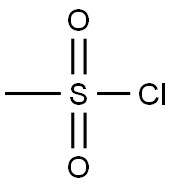
Метансульфонилхлорид
- английское имяMethanesulfonyl chloride
- CAS №124-63-0
- CBNumberCB6174525
- ФормулаCH3ClO2S
- мольный вес114.55
- EINECS204-706-1
- номер MDLMFCD00007454
- файл Mol124-63-0.mol
| Температура плавления | -33°C |
| Температура кипения | 60 °C/21 mmHg (lit.) |
| плотность | 1.48 g/mL at 25 °C (lit.) |
| давление пара | 3.001-8.9hPa at 20-25℃ |
| показатель преломления | n |
| Fp | >230 °F |
| температура хранения | 2-8°C |
| растворимость | Chloroform, Hexanes |
| форма | Liquid |
| цвет | Clear |
| Запах | Unpleasant odor |
| Растворимость в воде | Miscible with alcohol, ether and organic solvents. Immiscible with water. |
| Чувствительный | Moisture Sensitive |
| Мерк | 14,5955 |
| БРН | 506297 |
| Стабильность | Moisture Sensitive |
| LogP | -0.78-1.27 at 25℃ |
| Surface tension | 72.5mN/m at 1.1g/L and 21℃ |
| Справочник по базе данных CAS | 124-63-0(CAS DataBase Reference) |
| Непрямые добавки, используемые в веществах, контактирующих с пищевыми продуктами | SULFOLANE |
| Рейтинг продуктов питания EWG | 1 |
| FDA UNII | B17EWY1R7Q |
| Справочник по химии NIST | Methanesulfonyl chloride(124-63-0) |
| Система регистрации веществ EPA | Methanesulfonyl chloride (124-63-0) |
| UNSPSC Code | 12352106 |
| NACRES | NA.22 |
| Коды опасности | T+,T,C |
| Заявления о рисках | 24/25-26-34-37-35-22-41 |
| Заявления о безопасности | 26-28-36/37/39-45-25-28A |
| РИДАДР | UN 3246 6.1/PG 1 |
| WGK Германия | 2 |
| RTECS | PB2790000 |
| Температура самовоспламенения | 435°C |
| Примечание об опасности | Toxic/Corrosive |
| TSCA | Yes |
| Класс опасности | 6.1 |
| Группа упаковки | I |
| кода HS | 29049095 |
| Банк данных об опасных веществах | 124-63-0(Hazardous Substances Data) |
рисовальное письмо(GHS)
-
рисовальное письмо(GHS)


-
сигнальный язык
опасность
-
вредная бумага
H335:Может вызывать раздражение верхних дыхательных путей.
H317:При контакте с кожей может вызывать аллергическую реакцию.
H314:При попадании на кожу и в глаза вызывает химические ожоги.
H330:Смертельно при вдыхании.
H301+H311:Токсично при проглатывании или при контакте с кожей.
H290:Может вызывать коррозию металлов.
-
оператор предупредительных мер
P234:Хранить только в оригинальной упаковке.
P260:Не вдыхать газ/ пары/ пыль/ аэрозоли/ дым/ туман.
P280:Использовать перчатки/ средства защиты глаз/ лица.
P303+P361+P353:ПРИ ПОПАДАНИИ НА КОЖУ (или волосы): Снять/удалить немедленно всю загрязненную одежду. Промыть кожу водой.
P304+P340+P310:ПРИ ВДЫХАНИИ: Свежий воздух, покой. Немедленно обратиться за медицинской помощью.
P305+P351+P338:ПРИ ПОПАДАНИИ В ГЛАЗА: Осторожно промыть глаза водой в течение нескольких минут. Снять контактные линзы, если Вы ими пользуетесь и если это легко сделать. Продолжить промывание глаз.
Метансульфонилхлорид химические свойства, назначение, производство
Химические свойства
Colorless to yellow liquidИспользование
Methanesulfonyl chloride is used as a reagent for conversion of alcohols to mesylate esters such as methanesulfonate, which is an intermediate in substitution reactions, elimination reactions, reductions, and rearrangement reactions viz. Beckmann rearrangement. It is an electrophile and acts as a source of CH3SO2+ group. It is also used to prepare beta-chloro sulfones, methanesulfonamide and heterocyclic compounds containing five membered sultones.Общее описание
A pale yellow corrosive liquid. More dense than water and insoluble in water. Very toxic by ingestion, inhalation, or skin absorption.Профиль реактивности
Methanesulfonyl chloride reacts vigorously with water, steam, alkali, methylformamide. Emits toxic fumes of chloride and oxides of sulfur when heated to decomposition. A dangerous storage hazard. Reacts explosively with dimethyl sulfoxide [Buckley, A., J. Chem. Educ., 1965, 42, p. 674]. May react vigorously or explosively if mixed with diisopropyl ether or other ethers in the presence of trace amounts of metal salts [J. Haz. Mat., 1981, 4, 291].Угроза здоровью
TOXIC; inhalation, ingestion or contact (skin, eyes) with vapors, dusts or substance may cause severe injury, burns or death. Contact with molten substance may cause severe burns to skin and eyes. Reaction with water or moist air will release toxic, corrosive or flammable gases. Reaction with water may generate much heat that will increase the concentration of fumes in the air. Fire will produce irritating, corrosive and/or toxic gases. Runoff from fire control or dilution water may be corrosive and/or toxic and cause pollution.Пожароопасность
Combustible material: may burn but does not ignite readily. Substance will react with water (some violently) releasing flammable, toxic or corrosive gases and runoff. When heated, vapors may form explosive mixtures with air: indoors, outdoors and sewers explosion hazards. Most vapors are heavier than air. They will spread along ground and collect in low or confined areas (sewers, basements, tanks). Vapors may travel to source of ignition and flash back. Contact with metals may evolve flammable hydrogen gas. Containers may explode when heated or if contaminated with water.Возможный контакт
Chemical intermediate in various industries including pesticides, flame retardants, pharmaceuticals, plastics. A solvent, curing agent, and chemical stabilizer. Laboratory chemical.Перевозки
UN3246 Methanesulfonyl chloride, Hazard Class 6.1; Labels: 6.1-Poison Inhalation Hazard, 8-Corrosive material, Inhalation Hazard Zone B.Методы очистки
Distil the sulfonyl chloride from P2O5 under vacuum. It is a strong IRRITANT.[Beilstein 4 IV 27.]Несовместимости
Vapors may form explosive mixture with air. Slowly reacts with water, releasing toxic and corrosive hydrogen chloride gas. Incompatible with oxidizers (chlorates, nitrates, peroxides, permanganates, perchlorates, chlorine, bromine, fluorine, etc.); contact may cause fires or explosions. Keep away from alkaline materials, DMSO, ethers, strong acids, strong bases.Утилизация отходов
Use a licensed professional waste disposal service to dispose of this material. Dissolve or mix the material with a combustible solvent and burn in a chemical incinerator equipped with an afterburner and scrubber. All federal, state, and local environmental regulations must be observedМетансульфонилхлорид запасные части и сырье
сырьё
1of2
запасной предмет
- Нимесулид
- 9-Fluoro-11,17,21-trihydroxy-16-methylpregna-1,4-diene-3,20-dione21-phosphate piperazine salt
- Азтреонам
- 2-(Methanesulfonylamino)phenylboronic acid
- Амсакрин
- Ралоксифен
- 1,3-пропан сультон
- 5-аминосалициловая кислота
- 1-(Tetrahydro-2H-pyran-4-yl)hydrazine
- Бусульфан
- (4S)-4-hydroxy-3-methyl-2-prop-2-ynyl-cyclopent-2-en-1-one
- Олсалазин
- Метансульфонамид
- (-)-ДИОП
- Cefcapene pivoxil
- Halobetasol propionate
- Ставудин
- Этиловый methylsulfonylacetate
- 4-(Methylsulfonamido)aniline
- Фексофенадин
- TERT-BUTYL 4-(AMINOMETHYL)PYRIDIN-2-YLCARBAMATE
- (2-TERT-BUTOXYFORMAMIDO-PYRIDIN-4-YL)METHYL METHANESULFONATE
- 3-(BOC-амино)пирролидин
- (4S)-HYDROXY-3-METHYL-2-(2-PROPENYL)-2-CYCLOPENTENE-1-ONE
- 2-амино-4 ,5-дифторбензойную кисло
1of8